Individual Reflection Report: Teamwork, Skills, and Models
VerifiedAdded on 2023/01/07
|6
|1412
|83
Report
AI Summary
This individual reflection report examines the author's personal experiences and team skills developed while working on a workplace group project. The report utilizes Kolb's reflection model to analyze the author's learning and development, focusing on the practical application of team building theories and models. It delves into the Concrete Experience, Reflective Observation, Abstract Conceptualization, and Active Experimentation phases, providing insights into Belbin's team roles (action, people, and thought-oriented roles) and Tuckman's stages of team development (Forming, Storming, Norming, Performing, and Adjourning). The author reflects on how these models enhanced communication, leadership, coordination, and research skills, concluding with a discussion on future improvements, such as using Work Breakdown Structure and Gantt charts for better time management. The report emphasizes the importance of communication and coordination within a team environment.
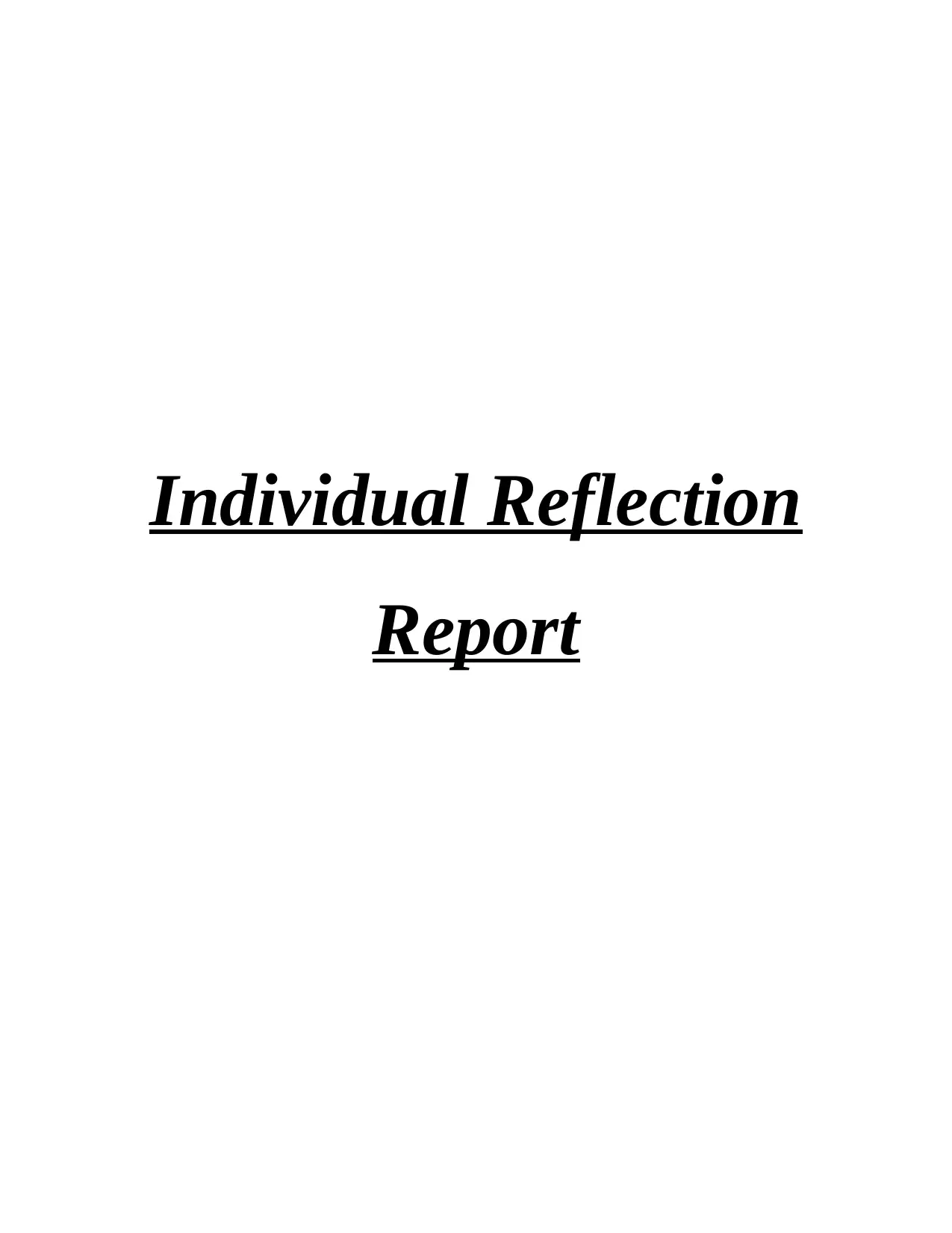
Individual Reflection
Report
Report
Paraphrase This Document
Need a fresh take? Get an instant paraphrase of this document with our AI Paraphraser
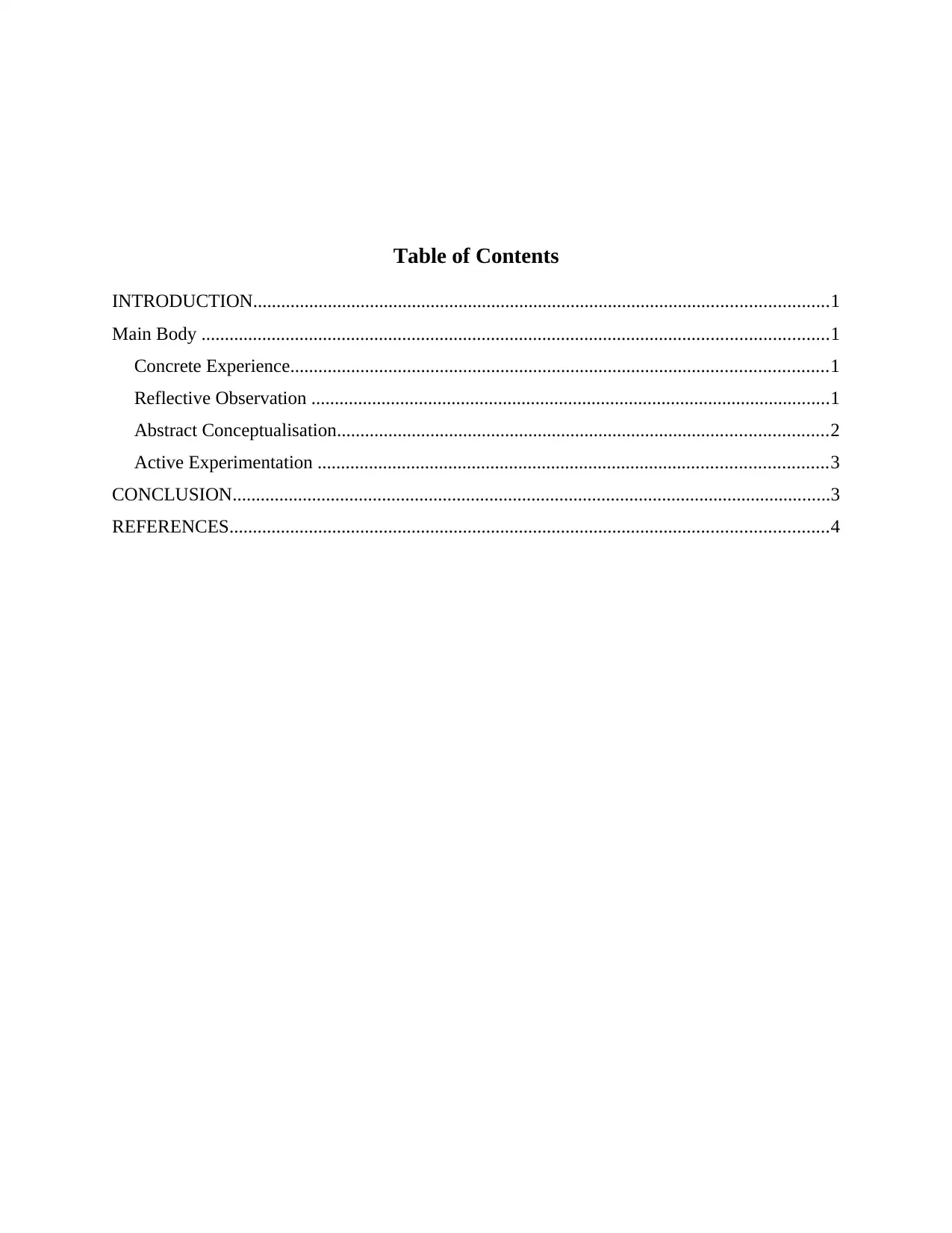
Table of Contents
INTRODUCTION...........................................................................................................................1
Main Body ......................................................................................................................................1
Concrete Experience...................................................................................................................1
Reflective Observation ...............................................................................................................1
Abstract Conceptualisation.........................................................................................................2
Active Experimentation .............................................................................................................3
CONCLUSION................................................................................................................................3
REFERENCES................................................................................................................................4
INTRODUCTION...........................................................................................................................1
Main Body ......................................................................................................................................1
Concrete Experience...................................................................................................................1
Reflective Observation ...............................................................................................................1
Abstract Conceptualisation.........................................................................................................2
Active Experimentation .............................................................................................................3
CONCLUSION................................................................................................................................3
REFERENCES................................................................................................................................4
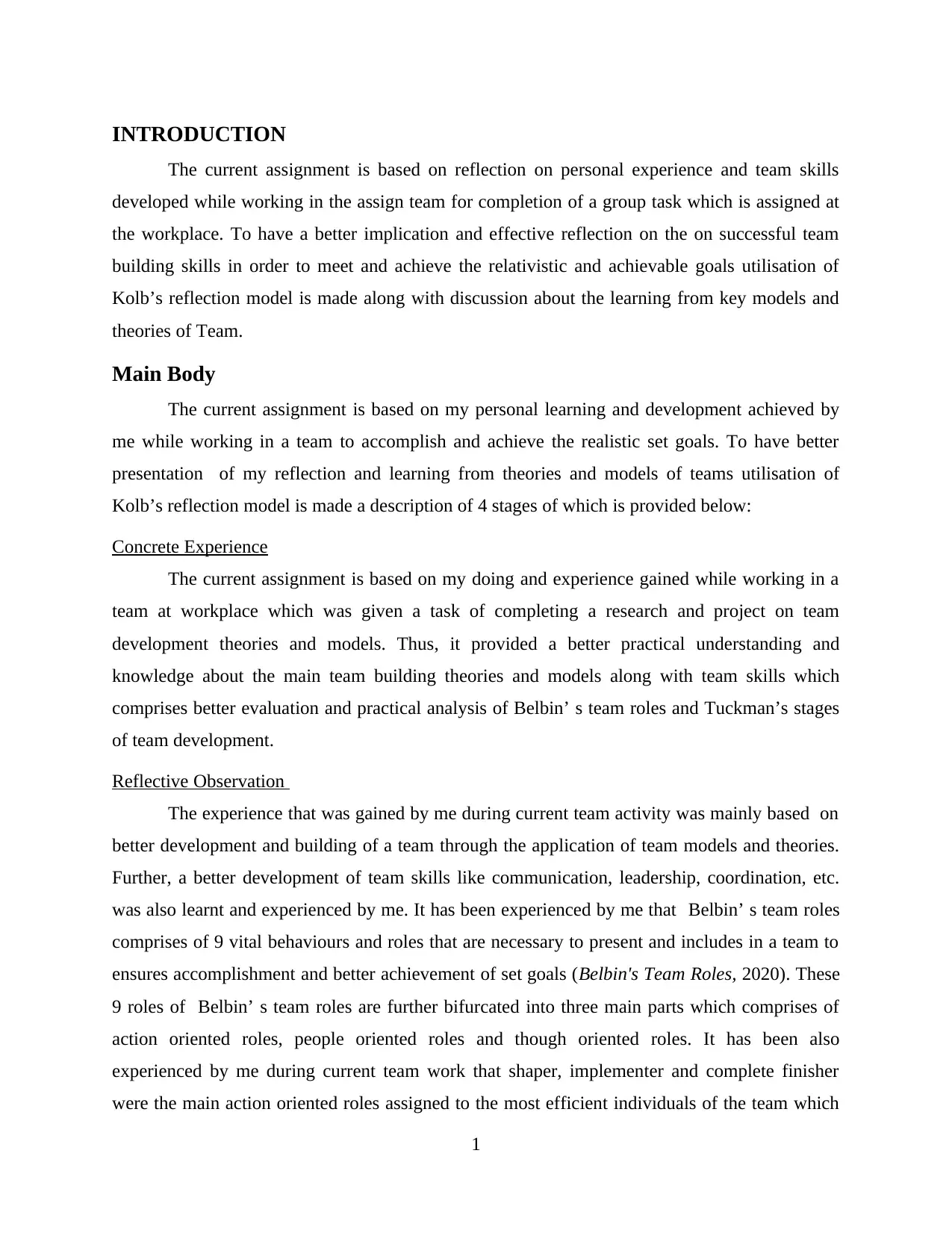
INTRODUCTION
The current assignment is based on reflection on personal experience and team skills
developed while working in the assign team for completion of a group task which is assigned at
the workplace. To have a better implication and effective reflection on the on successful team
building skills in order to meet and achieve the relativistic and achievable goals utilisation of
Kolb’s reflection model is made along with discussion about the learning from key models and
theories of Team.
Main Body
The current assignment is based on my personal learning and development achieved by
me while working in a team to accomplish and achieve the realistic set goals. To have better
presentation of my reflection and learning from theories and models of teams utilisation of
Kolb’s reflection model is made a description of 4 stages of which is provided below:
Concrete Experience
The current assignment is based on my doing and experience gained while working in a
team at workplace which was given a task of completing a research and project on team
development theories and models. Thus, it provided a better practical understanding and
knowledge about the main team building theories and models along with team skills which
comprises better evaluation and practical analysis of Belbin’ s team roles and Tuckman’s stages
of team development.
Reflective Observation
The experience that was gained by me during current team activity was mainly based on
better development and building of a team through the application of team models and theories.
Further, a better development of team skills like communication, leadership, coordination, etc.
was also learnt and experienced by me. It has been experienced by me that Belbin’ s team roles
comprises of 9 vital behaviours and roles that are necessary to present and includes in a team to
ensures accomplishment and better achievement of set goals (Belbin's Team Roles, 2020). These
9 roles of Belbin’ s team roles are further bifurcated into three main parts which comprises of
action oriented roles, people oriented roles and though oriented roles. It has been also
experienced by me during current team work that shaper, implementer and complete finisher
were the main action oriented roles assigned to the most efficient individuals of the team which
1
The current assignment is based on reflection on personal experience and team skills
developed while working in the assign team for completion of a group task which is assigned at
the workplace. To have a better implication and effective reflection on the on successful team
building skills in order to meet and achieve the relativistic and achievable goals utilisation of
Kolb’s reflection model is made along with discussion about the learning from key models and
theories of Team.
Main Body
The current assignment is based on my personal learning and development achieved by
me while working in a team to accomplish and achieve the realistic set goals. To have better
presentation of my reflection and learning from theories and models of teams utilisation of
Kolb’s reflection model is made a description of 4 stages of which is provided below:
Concrete Experience
The current assignment is based on my doing and experience gained while working in a
team at workplace which was given a task of completing a research and project on team
development theories and models. Thus, it provided a better practical understanding and
knowledge about the main team building theories and models along with team skills which
comprises better evaluation and practical analysis of Belbin’ s team roles and Tuckman’s stages
of team development.
Reflective Observation
The experience that was gained by me during current team activity was mainly based on
better development and building of a team through the application of team models and theories.
Further, a better development of team skills like communication, leadership, coordination, etc.
was also learnt and experienced by me. It has been experienced by me that Belbin’ s team roles
comprises of 9 vital behaviours and roles that are necessary to present and includes in a team to
ensures accomplishment and better achievement of set goals (Belbin's Team Roles, 2020). These
9 roles of Belbin’ s team roles are further bifurcated into three main parts which comprises of
action oriented roles, people oriented roles and though oriented roles. It has been also
experienced by me during current team work that shaper, implementer and complete finisher
were the main action oriented roles assigned to the most efficient individuals of the team which
1
⊘ This is a preview!⊘
Do you want full access?
Subscribe today to unlock all pages.

Trusted by 1+ million students worldwide
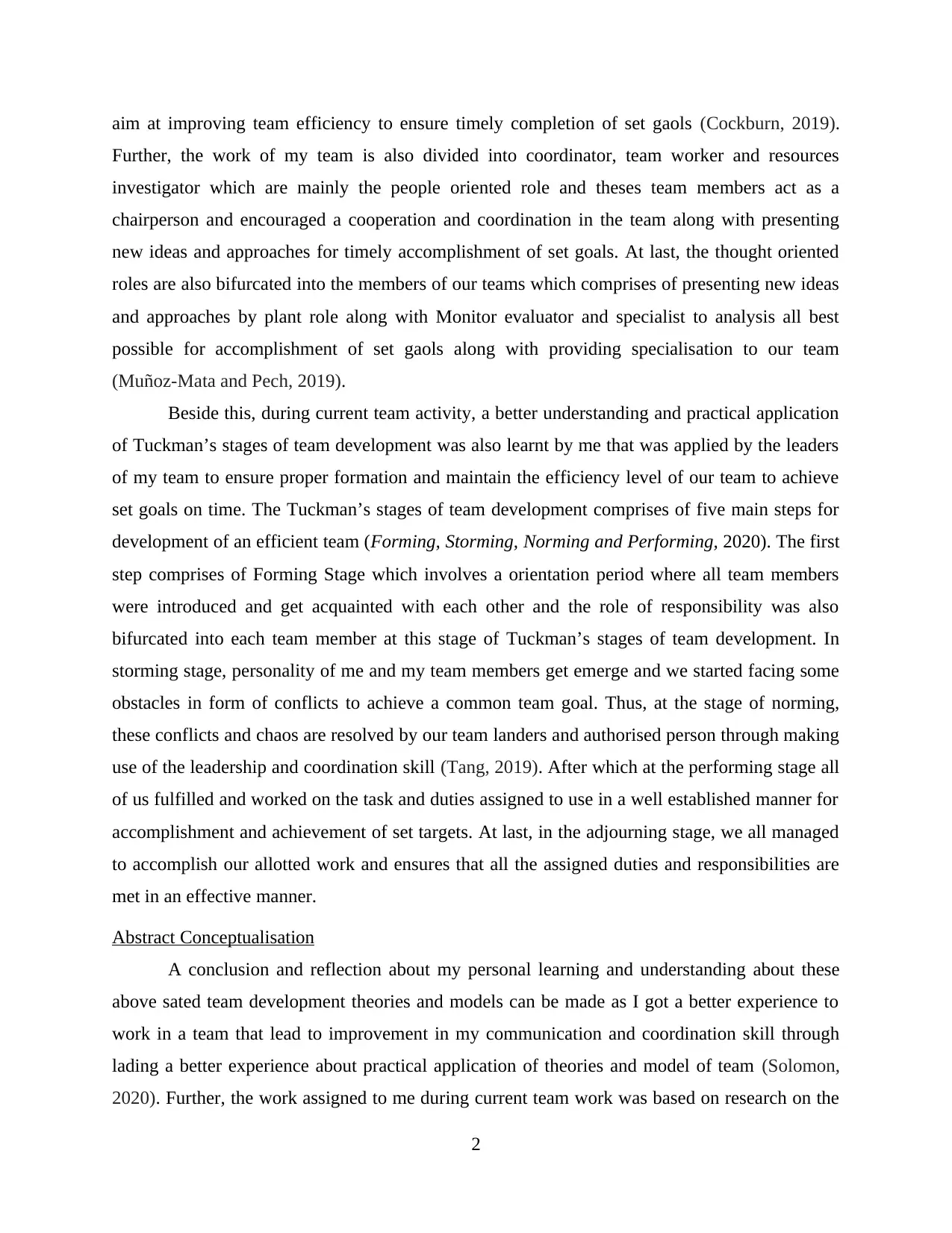
aim at improving team efficiency to ensure timely completion of set gaols (Cockburn, 2019).
Further, the work of my team is also divided into coordinator, team worker and resources
investigator which are mainly the people oriented role and theses team members act as a
chairperson and encouraged a cooperation and coordination in the team along with presenting
new ideas and approaches for timely accomplishment of set goals. At last, the thought oriented
roles are also bifurcated into the members of our teams which comprises of presenting new ideas
and approaches by plant role along with Monitor evaluator and specialist to analysis all best
possible for accomplishment of set gaols along with providing specialisation to our team
(Muñoz-Mata and Pech, 2019).
Beside this, during current team activity, a better understanding and practical application
of Tuckman’s stages of team development was also learnt by me that was applied by the leaders
of my team to ensure proper formation and maintain the efficiency level of our team to achieve
set goals on time. The Tuckman’s stages of team development comprises of five main steps for
development of an efficient team (Forming, Storming, Norming and Performing, 2020). The first
step comprises of Forming Stage which involves a orientation period where all team members
were introduced and get acquainted with each other and the role of responsibility was also
bifurcated into each team member at this stage of Tuckman’s stages of team development. In
storming stage, personality of me and my team members get emerge and we started facing some
obstacles in form of conflicts to achieve a common team goal. Thus, at the stage of norming,
these conflicts and chaos are resolved by our team landers and authorised person through making
use of the leadership and coordination skill (Tang, 2019). After which at the performing stage all
of us fulfilled and worked on the task and duties assigned to use in a well established manner for
accomplishment and achievement of set targets. At last, in the adjourning stage, we all managed
to accomplish our allotted work and ensures that all the assigned duties and responsibilities are
met in an effective manner.
Abstract Conceptualisation
A conclusion and reflection about my personal learning and understanding about these
above sated team development theories and models can be made as I got a better experience to
work in a team that lead to improvement in my communication and coordination skill through
lading a better experience about practical application of theories and model of team (Solomon,
2020). Further, the work assigned to me during current team work was based on research on the
2
Further, the work of my team is also divided into coordinator, team worker and resources
investigator which are mainly the people oriented role and theses team members act as a
chairperson and encouraged a cooperation and coordination in the team along with presenting
new ideas and approaches for timely accomplishment of set goals. At last, the thought oriented
roles are also bifurcated into the members of our teams which comprises of presenting new ideas
and approaches by plant role along with Monitor evaluator and specialist to analysis all best
possible for accomplishment of set gaols along with providing specialisation to our team
(Muñoz-Mata and Pech, 2019).
Beside this, during current team activity, a better understanding and practical application
of Tuckman’s stages of team development was also learnt by me that was applied by the leaders
of my team to ensure proper formation and maintain the efficiency level of our team to achieve
set goals on time. The Tuckman’s stages of team development comprises of five main steps for
development of an efficient team (Forming, Storming, Norming and Performing, 2020). The first
step comprises of Forming Stage which involves a orientation period where all team members
were introduced and get acquainted with each other and the role of responsibility was also
bifurcated into each team member at this stage of Tuckman’s stages of team development. In
storming stage, personality of me and my team members get emerge and we started facing some
obstacles in form of conflicts to achieve a common team goal. Thus, at the stage of norming,
these conflicts and chaos are resolved by our team landers and authorised person through making
use of the leadership and coordination skill (Tang, 2019). After which at the performing stage all
of us fulfilled and worked on the task and duties assigned to use in a well established manner for
accomplishment and achievement of set targets. At last, in the adjourning stage, we all managed
to accomplish our allotted work and ensures that all the assigned duties and responsibilities are
met in an effective manner.
Abstract Conceptualisation
A conclusion and reflection about my personal learning and understanding about these
above sated team development theories and models can be made as I got a better experience to
work in a team that lead to improvement in my communication and coordination skill through
lading a better experience about practical application of theories and model of team (Solomon,
2020). Further, the work assigned to me during current team work was based on research on the
2
Paraphrase This Document
Need a fresh take? Get an instant paraphrase of this document with our AI Paraphraser
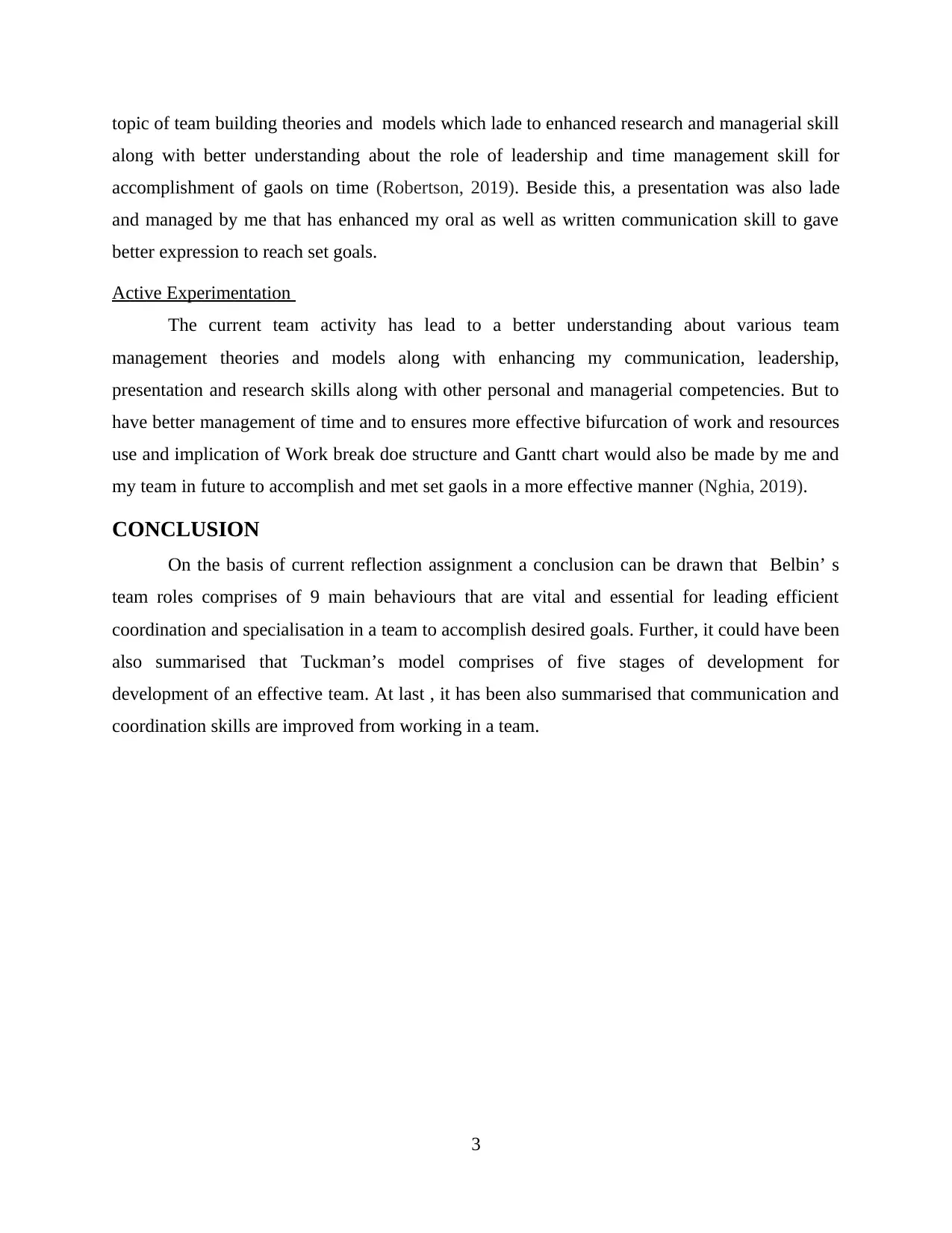
topic of team building theories and models which lade to enhanced research and managerial skill
along with better understanding about the role of leadership and time management skill for
accomplishment of gaols on time (Robertson, 2019). Beside this, a presentation was also lade
and managed by me that has enhanced my oral as well as written communication skill to gave
better expression to reach set goals.
Active Experimentation
The current team activity has lead to a better understanding about various team
management theories and models along with enhancing my communication, leadership,
presentation and research skills along with other personal and managerial competencies. But to
have better management of time and to ensures more effective bifurcation of work and resources
use and implication of Work break doe structure and Gantt chart would also be made by me and
my team in future to accomplish and met set gaols in a more effective manner (Nghia, 2019).
CONCLUSION
On the basis of current reflection assignment a conclusion can be drawn that Belbin’ s
team roles comprises of 9 main behaviours that are vital and essential for leading efficient
coordination and specialisation in a team to accomplish desired goals. Further, it could have been
also summarised that Tuckman’s model comprises of five stages of development for
development of an effective team. At last , it has been also summarised that communication and
coordination skills are improved from working in a team.
3
along with better understanding about the role of leadership and time management skill for
accomplishment of gaols on time (Robertson, 2019). Beside this, a presentation was also lade
and managed by me that has enhanced my oral as well as written communication skill to gave
better expression to reach set goals.
Active Experimentation
The current team activity has lead to a better understanding about various team
management theories and models along with enhancing my communication, leadership,
presentation and research skills along with other personal and managerial competencies. But to
have better management of time and to ensures more effective bifurcation of work and resources
use and implication of Work break doe structure and Gantt chart would also be made by me and
my team in future to accomplish and met set gaols in a more effective manner (Nghia, 2019).
CONCLUSION
On the basis of current reflection assignment a conclusion can be drawn that Belbin’ s
team roles comprises of 9 main behaviours that are vital and essential for leading efficient
coordination and specialisation in a team to accomplish desired goals. Further, it could have been
also summarised that Tuckman’s model comprises of five stages of development for
development of an effective team. At last , it has been also summarised that communication and
coordination skills are improved from working in a team.
3
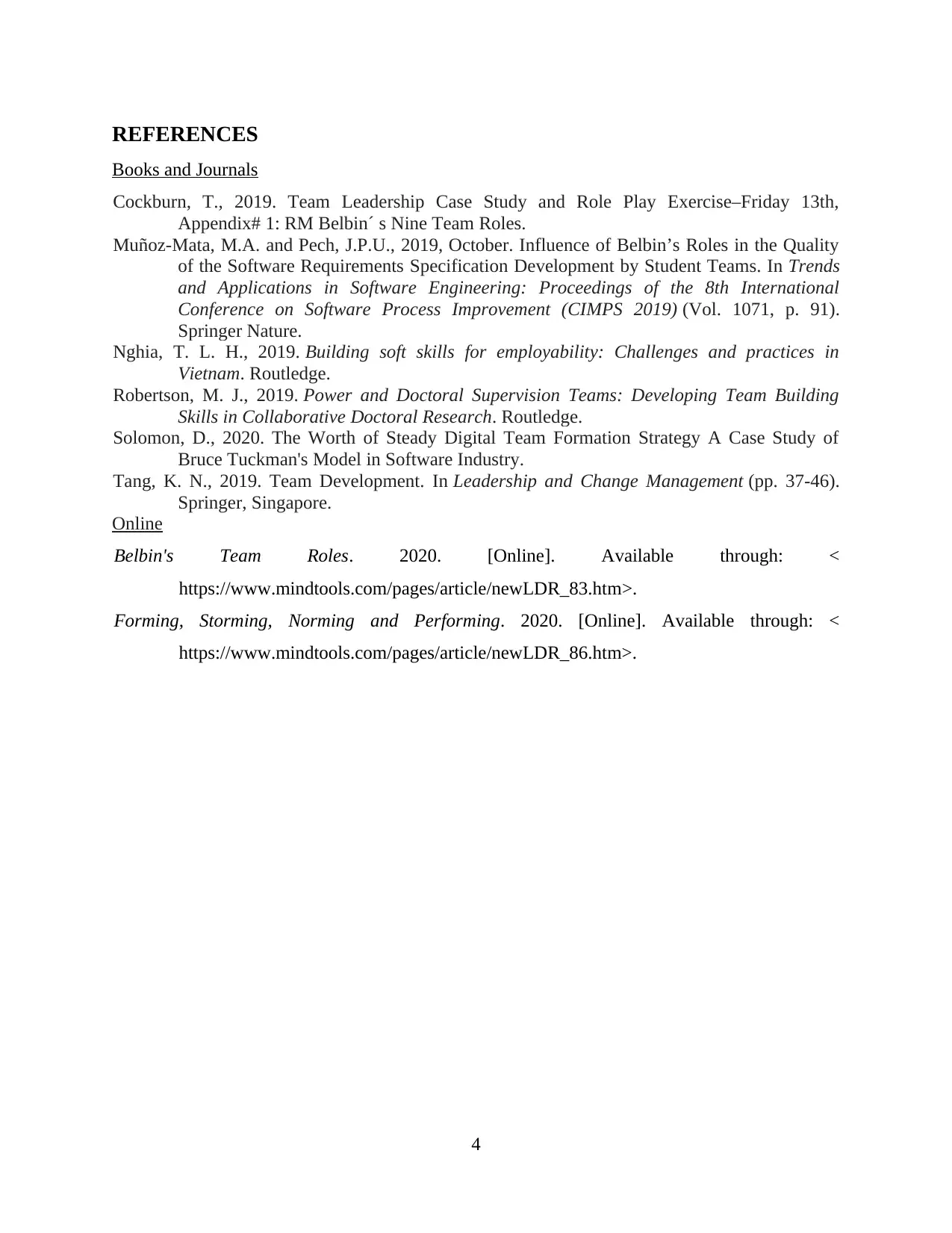
REFERENCES
Books and Journals
Cockburn, T., 2019. Team Leadership Case Study and Role Play Exercise–Friday 13th,
Appendix# 1: RM Belbin´ s Nine Team Roles.
Muñoz-Mata, M.A. and Pech, J.P.U., 2019, October. Influence of Belbin’s Roles in the Quality
of the Software Requirements Specification Development by Student Teams. In Trends
and Applications in Software Engineering: Proceedings of the 8th International
Conference on Software Process Improvement (CIMPS 2019) (Vol. 1071, p. 91).
Springer Nature.
Nghia, T. L. H., 2019. Building soft skills for employability: Challenges and practices in
Vietnam. Routledge.
Robertson, M. J., 2019. Power and Doctoral Supervision Teams: Developing Team Building
Skills in Collaborative Doctoral Research. Routledge.
Solomon, D., 2020. The Worth of Steady Digital Team Formation Strategy A Case Study of
Bruce Tuckman's Model in Software Industry.
Tang, K. N., 2019. Team Development. In Leadership and Change Management (pp. 37-46).
Springer, Singapore.
Online
Belbin's Team Roles. 2020. [Online]. Available through: <
https://www.mindtools.com/pages/article/newLDR_83.htm>.
Forming, Storming, Norming and Performing. 2020. [Online]. Available through: <
https://www.mindtools.com/pages/article/newLDR_86.htm>.
4
Books and Journals
Cockburn, T., 2019. Team Leadership Case Study and Role Play Exercise–Friday 13th,
Appendix# 1: RM Belbin´ s Nine Team Roles.
Muñoz-Mata, M.A. and Pech, J.P.U., 2019, October. Influence of Belbin’s Roles in the Quality
of the Software Requirements Specification Development by Student Teams. In Trends
and Applications in Software Engineering: Proceedings of the 8th International
Conference on Software Process Improvement (CIMPS 2019) (Vol. 1071, p. 91).
Springer Nature.
Nghia, T. L. H., 2019. Building soft skills for employability: Challenges and practices in
Vietnam. Routledge.
Robertson, M. J., 2019. Power and Doctoral Supervision Teams: Developing Team Building
Skills in Collaborative Doctoral Research. Routledge.
Solomon, D., 2020. The Worth of Steady Digital Team Formation Strategy A Case Study of
Bruce Tuckman's Model in Software Industry.
Tang, K. N., 2019. Team Development. In Leadership and Change Management (pp. 37-46).
Springer, Singapore.
Online
Belbin's Team Roles. 2020. [Online]. Available through: <
https://www.mindtools.com/pages/article/newLDR_83.htm>.
Forming, Storming, Norming and Performing. 2020. [Online]. Available through: <
https://www.mindtools.com/pages/article/newLDR_86.htm>.
4
⊘ This is a preview!⊘
Do you want full access?
Subscribe today to unlock all pages.

Trusted by 1+ million students worldwide
1 out of 6
Related Documents
Your All-in-One AI-Powered Toolkit for Academic Success.
+13062052269
info@desklib.com
Available 24*7 on WhatsApp / Email
![[object Object]](/_next/static/media/star-bottom.7253800d.svg)
Unlock your academic potential
Copyright © 2020–2025 A2Z Services. All Rights Reserved. Developed and managed by ZUCOL.





